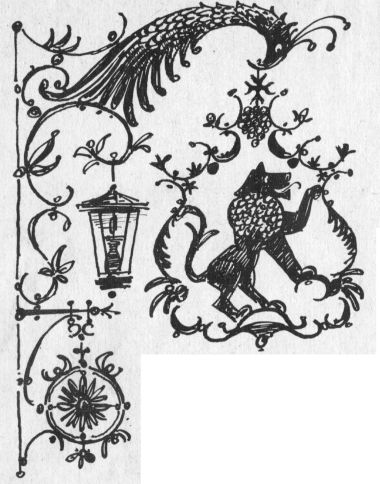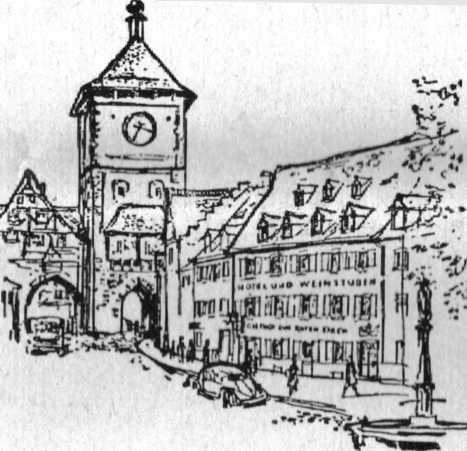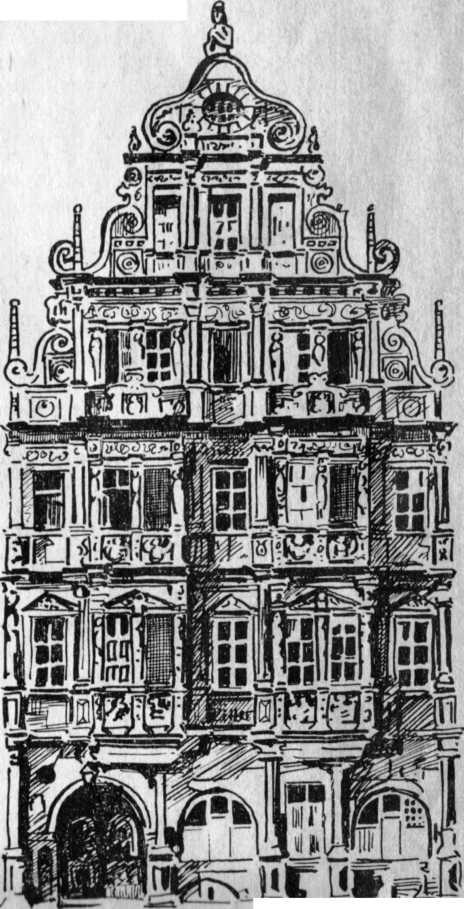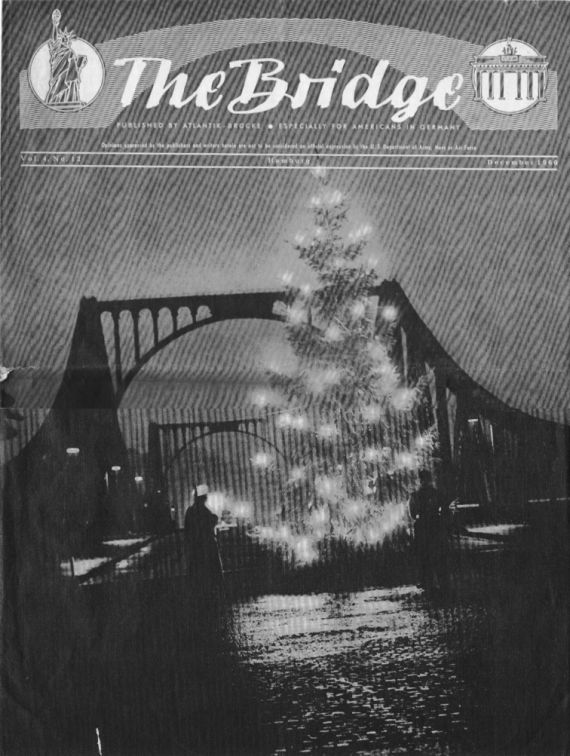|


The oldest German hotels date back to the times when the landlords still
welcomed their guests in Latin and even made out the bills in that language. Latin was the language of the
upper classes and only they afforded themselves the luxury of travel then.
Seigneur de Montaigne's Report
Seigneur Michel de Montaigne, for example, a French nobleman and
philosopher, to whom we owe the first critical remarks on German accomodation facilities, made a trip from his
castle in France to Rome in 1580.
He reported from Southern Germany that "the
courses at dinner are very manifold" there, that he found the featherbeds "quite acceptable," and that the
landlords were "bragging, hot-tempered and addicted to drink, but neither perfidious nor thievish." And in
Augsburg "the stairs are covered with linen to protect them from dirt."
He noted
that the Germans love coats of arms very much. "One sees masses of them on the walls; the noblemen who
passed through the place have left them behind." He praised "the
custom of burning fragrant spices in the rooms and in the stoves."
The "Cavalierstour"
Seigneur de Montaigne made his trip on horseback.
He was under way for 17 months and had four noble companions and many servants with
him. The huge luggage was carried by asses, at whose sides shouting and clubbing drovers ran. This was what was
then called a "cavalierstour".
In his travel report, Montaigne mentioned the
inns "Zum Adler" and "Zum Hecht" in Konstanz,
the "Post" in Sma-dorf, and the "Krone" in Lindau. The
"Hecht" exists to this day, and also the nobleman de Montaigne has
not been forgotten at this place so noteworthy for the history of gastronomy. Actually, most historical inns can
be found in the South of Germany. Perhaps this fact has something to do with the wine, which used to refine the
culture of a region in a very special way. "They are harvesting in the region," wrote Montaigne, "all is full of
vines." And: "Everywhere one drinks wine out of large, mostly well-finished and gilded silver jugs."
Germany's Oldest Inn
At the time when Montaigne traveled, the hotel "Zum Roten Bären"
in Freiburg in the Breisgau was already almost 200
years old. The first document mentioning this house dates from March 13, 1387.
Researchers believe that it was founded in 1120. If the researchers
are right — and mostly they are — "Zum Bären" in Freiburg is
Germany's oldest "Gasthof".
Another contender for the honor of being "the oldest hotel in the German Reich" is the
"Riese" in Miltenberg on the Main river, a princely hostel, in which
the Emperor Barbarossa, Ludwig the Bavarian, and the Emperor Charles IV are said to have taken lodging. But the
documents of the "Riese" date only back as far as 1590, while the "Krone" in Kon-stanz can be traced until 1225.
Another "very old" inn is the "Kreuz" in Immen-dingen, which came into being in 1329.
Besides the "Hecht", in which Montaigne dined, Konstanz also has the "Barbarossa" and the "Insel-Hotel".
In Heidelberg is the "Ritter", from the 16th century, and in Berghausen (region of Baden) is the inn "Zur Laub",
from the 17th century. The guest books of such houses are storehouses of knowledge for the disciples of hotel
research.
The hotel "Zum Adler" in Hinterzarten (Black Forest) is still owned by the
same family that founded it in 1550. In the "Lowe" in Staufen the guest is shown a room in which the
historical

The hotel "Zum Bären" in Freiburg (the house on the
right) was founded in 1120.
Drawing: Courtesy „Zum Bären"
Dr. Faust spent his last hours in the year 1539. Not everybody knows
immediately who this historical Dr. Faust was, but all find it exciting. The inn "Zur Kanne" in Deidesheim on
the Wine-Road boasts of existing "since the 12th century."
Still standing in Marbach (Württemberg) is
the "Goldener Löwe", the house in which Friedrich Schiller's
mother was born. Schiller liked to visit the "Goldener Ochse" in Stuttgart
which — like so many old inns in Nuremberg, Fürth, Ulm and Würzburg — was destroyed during the last war and not rebuilt. How many
tourists cherish memories of the "Bratwurstglöcklein" ("Little Fried-Sausage Bell")
and the "Goldenes Posthorn" in Nuremberg. In Würzburg, the "Stachel" and the "Kette" have been
rebuilt — both were famous inns, too.
Historical
Atmosphere In Rothenburg ob der Tauber, the "Eisenhut" still ranks as a first-class attraction. The Thirty-Years War (a devastating European war, which lasted
from 1618 till 1648) is still in the walls of such houses;
the guest almost hears the clanking of helmets and smells the leather, and through the window snorts a
horse ...
Only in a few houses in Northern Germany is the adventurous atmosphere from the old days of the
sailing vessels preserved, for instance in the "Bremer Ratskeller", the
"Schiffergesellschaft" in Lübeck and the "Holländerei"
in Meldorf in Holstein. The "Himmelsleiter" in Hamburg was frequented by the poets Lilieneron and Löns and by the
painter Menzel. The "Bär" in Göttinnen,
the "Kaiserworth" in Goslar and the "Dom-herrenschenke"
in Hildesheim are inns with a centuries-old tradition. In Hanover, the
"Haus der Väter", the inn "Zum Vrenschenhagen" and the
historical "Kreuzklappe" have disappeared.
Memories of
Goethe Aachen still has its "Postwagen", Düsseldorf the "Tante Anna" and cologne the "Weinhaus Duhr".
On the Rhino, the "Lindenwirtin" in Godesberg, the "Goldener Propfenzieher" in Ober-wesel, the "Königsstuhl"
in Rhens and the "Altes Haus" in Bacharach are reknowned old inns. In Walporzheim (Ahr Valley) we find "Sankt
Peter" and, not far away, the "Lochmühle". Münster has the "Altbierstuben Pinkus Müller" and Osnabrück the
"Walhalla", where the composer Albert Lortzing drank his wine.
Frankfurt lost its "Schwarzer Stern", the "Drei Rinder", the "Alte Dorfschmiede" and the house "Zum Stift".
The "Gerbermühle", with its memories of Goethe, has been rebuilt. In Aßmannshausen the famous
"Krone" still stands and in Bad Hersfeld the "Stern". Mainz and Kassel have lost their oldest inns, but in Marburg
(Lahn) the "Wirtshaus an der Lahn" still enjoys robust popularity; its fame even rotates, with 45 r.p.m., on a
record (only suitable for men's parties, though).
This enumeration of historical inns
in Western Germany is neither quite correct nor is it complete. Over the years various wars did their devastating
work. It is hard in many instances to find a beam which bears the exact date.
Courtesy: DIE WELT


Hotel "Zum Ritter" in Heidelberg, built 1592. It is the only private house
in Heidelberg which survived the great Fire of 1693.
Drawings (2): Jürgen Brandes 1960,
Aus:

| 




